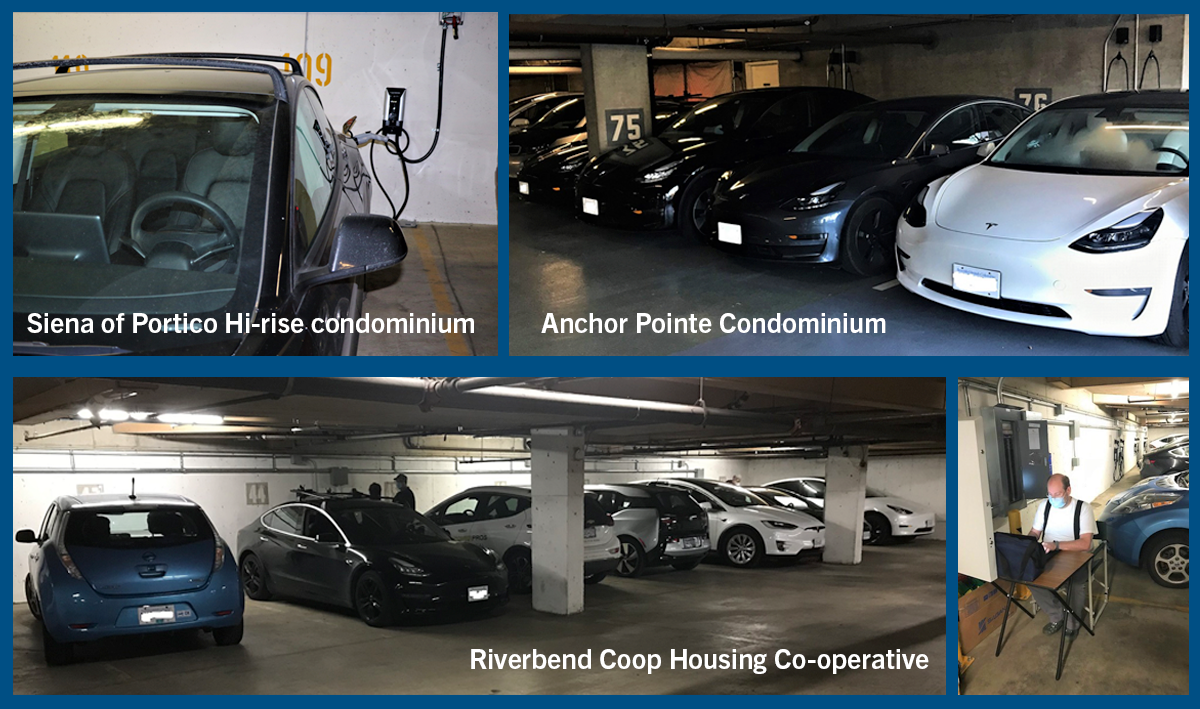The BCIT Smart Microgrid Applied Research Team (SMART) successfully developed a blueprint to retrofit 20 electric vehicle (EV) charging stations into three multi-unit residential buildings (MURBS).
This research project aimed to design an efficient and scalable plan to install EV charging stations in existing condominiums and rental apartments in the Greater Vancouver area.

The SMART team selected three sites for this research project: Riverbend Coop Housing in New Westminster, Anchor Pointe condominium in New Westminster, and Siena of Portico high-rise condominium in Vancouver. For the selected MURBs, BCIT and their electrical engineers reviewed the building’s electrical capacity for adding EV chargers and developed a scalable electrical plan that could eventually provide charging to the entire parking garage.
Level 1 charging units typically operate on electric power of 120 volts, 15 Amp circuits, offering about 1.4 KW of power. Level 2 charging units use 240 volt and 40 Amp circuits, which provides a quicker more efficient charge for the EV.
Electric vehicle energy management systems (EVEMS) were deployed in these demonstration sites, allowing level two EV chargers to share power rather than be on individual dedicated circuits.
The EVEMS approach allows buildings to “stretch” their existing electrical capacity to permit the installation of many more EV chargers than the old dedicated circuit approach.
“The electrical infrastructure in the vast majority of MURBs were never designed to accommodate EV charging,” says Clay Howey, Research Head, SMART. “These installations are intended to serve as a blueprint for other condominiums and apartments to use in order to make the most efficient use of their existing electrical infrastructure, and to provide the greatest possible number of EV chargers.”
“The EV chargers are immensely beneficial to the resale values of multi-unit residential buildings – attracting new owners and also the option for current owners to purchase electric vehicles,” explains Bruce Campbell, Anchor Pointe, Council President. “We look forward to working with our fellow members by sharing our expertise and being a demonstration site to support in retrofitting older properties.”
One key component for the success of this project is the Open Charge Point Protocol (OCPP), which is a standard, open communication protocol for command and control of EV charging stations. This open standard approach gives MURBs the flexibility to select chargers from different vendors, and also use Charge Station Network Management Systems (CSNMS) from different vendors instead of being forced into a proprietary solution with a single vendor. BCIT has developed its own open-source OCPP-compliant CSNMS, deployed at Riverbend Coop, and used OCPP-compliant CSNMS from different vendors at the other two MURB installations.
“The BCIT OCPP ecosystem provides the back-office systems required to operate networked charging stations and provides the software stack required for charging station vendors to make their stations OCPP compliant,” says Kelly Carmichael, Project Lead, SMART. “The installation at Riverbend is using both the BCIT CSNMS, as well as charging stations provided by Sun Country Highway that use the BCIT OCPP charging station stack.”
With this research now complete, other strata and rental apartments can access these demonstration sites to help them develop a plan for installing EV chargers.
This federally funded project is provided through Natural Resources Canada’s Green Infrastructure – Electric Vehicle Infrastructure Demonstration Program, which aims to accelerate the market entry of next-generation clean energy technologies.
Presentations workshops from this project (February 2022).
ABOUT BCIT SMART MICROGRID APPLIED RESEARCH TEAM (SMART)
BCIT’s Smart Microgrid Applied Research Team is working on research, development and demonstration (RD&D) initiatives aimed at solutions that will reduce barriers to the adoption of Electric Vehicles (EVs). These projects build on a recently completed renewable (solar PV) energy generation, energy storage, and electric vehicle charging infrastructure project called Energy OASIS, located at BCIT’s Burnaby campus.

Congratulation
I’m very interested in persuing this option to provide EV charging in our 50 unit parkade in Kamloops. Any info as to how I would approach this would be greatly appreciated.
Thank you,
Dave Hay
Kamloops
( BCIT Alumni, Forest Products Wood option, class of ‘69)